Technology Transfer, Sustainability, and Development, Worldwide and in Romania
Abstract
1. Introduction
- Reduced competitiveness is the most pressing challenge for Romania, as it currently has a major negative impact on the Research, Development, and Innovation (RDI) system. The economy is largely composed of sectors which employ medium and low technology and maintain a poor innovation culture and a scarce demand for knowledge [20].
- Regarding the research and development (RD) intensity score, Romania is on the last position in the European Union (EU), due to reduced innovation activity. Corporate RD is also considered to be subpar. Illustrating the decreased innovation activity level, the country was ranked by the World Economic Forum Report on Global competitiveness 2013–2014 as mainly oriented towards efficiency (together with Latvia and Bulgaria), in comparison to the economies of more advanced EU member states, which are in transition towards/at the innovation focus stage [20,21].
- The “stop–start” pattern of development—which has detrimental consequences for economic sectors requiring constant capacity building over a long period of time—is determined by continuous political inconsistency, the absence of cooperation between ministries with RD portfolios, and the absence of an applicable innovation policy.
- In Romania, 38.3% of research activities are performed within the private business sector (the EU average being 61.5%), while the rest of all RD activity belongs exclusively to the state. The segmentation of public RD represents another negative structural feature, as despite the numerous researchers, the research is largely not conducive to clear and applicable results [21].
- The tight budget for the RDI system, combined with reduced career options, determined a massive exodus of researchers, which has been ongoing from 1990 until now. Romania finds itself lacking a researcher network, as 15,000 Romanian researchers are presently conducting their activity abroad.
- Regarding research excellence, Romanian universities are typically presented in the main international rankings as higher education institutions with poor scientific activity, mediocre research results, and a human resource structure which is less globalized in comparison to other EU countries [20,21].
- The RDI limitations in the business field are also alarming: few patent applications/requests in relation to the Patent Cooperation Treaty, the reduced presence of researchers in companies, and a reduced degree of corporate RD, which continues to decline over time.
- Regarding scientific and technological capacity, Romania presents prospective in new technologies of production, automotive, nanotechnology, information and computer technology, and security.
- The most important scientific fields are physics, astronomy and strategic enabling technologies, mathematics and statistics, engineering, information technologies and computers, as presented in the Romanian scientific specialization index, academic publications and citations [21].
2. Methodological Approaches
3. Global Technology Transfer
3.1. International TT
3.2. Technology Distribution
3.3. Conceptual Boundaries of TT
3.4. Networks and Innovation Development
3.5. Technological Expansion and Sustainable Economies
3.6. Global Regulatory Approaches
4. Technological Transfer in Romania
4.1. Regional Operational Programme
4.2. Collaborative Networks in TT Framework
4.3. Technology Transfer Centers
5. Technology Transfer Models
5.1. Gibson and Slimor’s Model
5.2. Sung and Gibson’s Model
5.3. Rebentisch and Ferretti’s Model
5.4. Linear Models of Technology Transfer
5.5. Non-Linear Parallel-Sequential Models
6. University Technology Transfer
Models of Entrepreneurial Universities and Knowledge Capitalization
7. Ethical Policies in the EU and Romania Related to the Process of Technology Transfer
8. Efficiency in Technology Transfer
9. Sustainability—A Strong Point in Technology Transfer
10. Conclusions
Author Contributions
Funding
Institutional Review Board Statement
Acknowledgments
Conflicts of Interest
References
- Etzkowitz, H.; Leydesdorff, L. The Dynamics of Innovation: From National Systems and “Mode 2” to a Triple Helix of University–Industry–Government Relations. Res. Policy 2000, 29, 109–123. [Google Scholar] [CrossRef]
- Spiegel, J. CHAPTER 23—Technology Transfer. In Principles and Practice of Clinical Research, 2nd ed.; Gallin, J.I., Ognibene, F.P., Eds.; Academic Press: Burlington, ON, Canada, 2007; pp. 315–334. [Google Scholar]
- Singh, S.; Behl, T.; Sharma, N.; Zahoor, I.; Chigurupati, S.; Yadav, S.; Rachamalla, M.; Sehgal, A.; Naved, T.; Pritima; et al. Targeting therapeutic approaches and highlighting the potential role of nanotechnology in atopic dermatitis. Environ. Sci. Pollut. Res. 2022, 29, 32605–32630. [Google Scholar] [CrossRef] [PubMed]
- Sabir, F.; Barani, M.; Mukhtar, M.; Rahdar, A.; Cucchiarini, M.; Zafar, M.N.; Behl, T.; Bungau, S. Nanodiagnosis and Nanotreatment of Cardiovascular Diseases: An Overview. Chemosensors 2021, 9, 67. [Google Scholar] [CrossRef]
- Behl, T.; Kaur, I.; Sehgal, A.; Singh, S.; Sharma, N.; Bhatia, S.; Al-Harrasi, A.; Bungau, S. The dichotomy of nanotechnology as the cutting edge of agriculture: Nano-farming as an asset versus nanotoxicity. Chemosphere 2022, 288, 132533. [Google Scholar] [CrossRef]
- Mukhtar, M.; Bilal, M.; Rahdar, A.; Barani, M.; Arshad Khan, R.; Behl, T.; Brisc, C.; Banica, F.; Bungau, S. Nanomaterials for Diagnosis and Treatment of Brain Cancer: Recent Updates. Sens. Rev. 2020, 8, 117. [Google Scholar] [CrossRef]
- Nechifor, G.; Grosu, A.R.; Ferencz, A.; Tanczos, S.-K.; Goran, A.; Grosu, V.-A.; Bungău, S.G.; Păncescu, F.M.; Albu, P.C.; Nechifor, A.C. Simultaneous Release of Silver Ions and 10-Undecenoic Acid from Silver Iron-Oxide Nanoparticles Impregnated Membranes. Membranes 2022, 12, 557. [Google Scholar] [CrossRef]
- Dimulescu, I.A.; Nechifor, A.C.; Bǎrdacǎ, C.; Oprea, O.; Paşcu, D.; Totu, E.E.; Albu, P.C.; Nechifor, G.; Bungău, S.G. Accessible Silver-Iron Oxide Nanoparticles as a Nanomaterial for Supported Liquid Membranes. Nanomaterials 2021, 11, 1204. [Google Scholar] [CrossRef]
- Bărdacă Urducea, C.; Nechifor, A.C.; Dimulescu, I.A.; Oprea, O.; Nechifor, G.; Totu, E.E.; Isildak, I.; Albu, P.C.; Bungău, S.G. Control of Nanostructured Polysulfone Membrane Preparation by Phase Inversion Method. Nanomaterials 2020, 10, 2349. [Google Scholar] [CrossRef]
- Klein, M.A. Patents, trade secrets and international technology transfer. Econ. Lett. 2022, 210, 110180. [Google Scholar] [CrossRef]
- Lemley, M.; Feldman, R. Patent Licensing, Technology Transfer, and Innovation. Am. Econ. Rev. 2016, 106, 188–192. [Google Scholar] [CrossRef]
- Zheng, Z.; Huang, C.-Y.; Yang, Y. Patent protection, innovation, and technology transfer in a Schumpeterian economy. Eur. Econ. Rev. 2020, 129, 103531. [Google Scholar] [CrossRef]
- Drivas, K.; Economidou, C.; Karamanis, D.; Zank, A. Academic patents and technology transfer. J. Eng. Technol. Manag. 2016, 40, 45–63. [Google Scholar] [CrossRef]
- European Patent Office. Technology Transfer Case Studies (Oxeon—Technical Textiles—Sweden). Available online: https://www.epo.org/learning/materials/sme/innovation-case-studies/technology-transfer-case-studies.html (accessed on 21 November 2022).
- European Patent Office. Technology Transfer Case Studies (Blubrake—Road Vehicles—Italy). Available online: https://www.epo.org/learning/materials/sme/innovation-case-studies/technology-transfer-case-studies.html (accessed on 21 November 2022).
- European Patent Office. Technology Transfer Case Studies (Cubicure—Additive Manufacturing—Austria). Available online: https://www.epo.org/learning/materials/sme/innovation-case-studies/technology-transfer-case-studies.html (accessed on 21 November 2022).
- European Patent Office. Technology Transfer Case Studies (fos4X—Measurement Technology—Germany). Available online: https://www.epo.org/learning/materials/sme/innovation-case-studies/technology-transfer-case-studies.html (accessed on 21 November 2022).
- Faunce, T.A. Technology Transfer. In Encyclopedia of Applied Ethics, 2nd ed.; Chadwick, R., Ed.; Academic Press: San Diego, CA, USA, 2012; pp. 328–333. [Google Scholar]
- Matt, G.E.; Brewer, A.; Sklar, M. External Validity. In International Encyclopedia of Education, 3rd ed.; Peterson, P., Baker, E., McGaw, B., Eds.; Elsevier: Oxford, UK, 2010; pp. 521–527. [Google Scholar]
- Miron, D. Linking the double helix of learning and work to the triple helix of university–industry–government in the Europe of knowledge. Manag. Mark. 2008, 3, 3–20. [Google Scholar]
- Ionescu, C. Challenges on the Integration of Romanian System Research, Development and Innovation in Innovation Union. Procedia Econ. Financ. 2015, 32, 986–991. [Google Scholar] [CrossRef]
- Page, M.J.; McKenzie, J.E.; Bossuyt, P.M.; Boutron, I.; Hoffmann, T.C.; Mulrow, C.D.; Shamseer, L.; Tetzlaff, J.M.; Akl, E.A.; Brennan, S.E.; et al. The PRISMA 2020 statement: An updated guideline for reporting systematic reviews. Rev. Esp. Cardiol. (Engl. Ed.) 2021, 74, 790–799. [Google Scholar] [CrossRef]
- Hao, Y.; Ba, N.; Ren, S.; Wu, H. How does international technology spillover affect China’s carbon emissions? A new perspective through intellectual property protection. Sustain. Prod. Consum. 2021, 25, 577–590. [Google Scholar] [CrossRef]
- Feng, W.; Li, J. International technology spillovers and innovation quality: Evidence from China. Econ. Anal. Policy 2021, 72, 289–308. [Google Scholar] [CrossRef]
- Evenson, R.E.; Westphal, L.E. Technological change and technology strategy. Handb. Dev. Econ. 1995, 3, 2209–2299. [Google Scholar]
- Keller, W. International Technology Diffusion. J. Econ. Lit. 2004, 42, 752–782. [Google Scholar] [CrossRef]
- Osano, H.M.; Koine, P.W. Role of foreign direct investment on technology transfer and economic growth in Kenya: A case of the energy sector. J. Innov. Entrep. 2016, 5, 31. [Google Scholar] [CrossRef]
- Grossman, G.; Helpman, E. Innovation and Growth in the Global Economy; The MIT Press: Cambridge, MA, USA, 1991. [Google Scholar]
- Souder, W.E.; Nashar, A.S.; Padmanabhan, V. A guide to the best technology-transfer practices. J. Technol. Transf. 1990, 15, 5–16. [Google Scholar] [CrossRef]
- Ramanathan, K. The role of technology transfer services in technology capacity building and enhancing the competitiveness of SMEs. In Proceedings of the Mongolia National Workshop on “Subnational Innovation systems and Technology Capacity-building Policies to Enhance Competitiveness of SMEs”; UN-ESCAP and ITMRC (Mongolia): Ulaanbaatar, Mongolia, 2007; pp. 21–22. [Google Scholar]
- Bozeman, B. Technology transfer and public policy: A review of research and theory. Res. Policy 2000, 29, 627–655. [Google Scholar] [CrossRef]
- Lundquist, D.G. A Rich Vision of Technology Transfer Technology Value Management. J. Technol. Transf. 2003, 28, 265–284. [Google Scholar] [CrossRef]
- Osman-Gani, A.A.M. International technology transfer for competitive advantage: A conceptual analysis of the role of HRD. Compet. Rev. Int. Bus. J. 1999, 9, 9–18. [Google Scholar]
- Phillips, R.G. Technology business incubators: How effective as technology transfer mechanisms? Technol. Soc. 2002, 24, 299–316. [Google Scholar] [CrossRef]
- Arrow, K.J. Classificatory notes on the production and transmission of technological knowledge. Am. Econ. Rev. 1969, 59, 29–35. [Google Scholar]
- Mittelman, J.H.; Pasha, M.K. Out from Underdevelopment Revisited: Changing Global Structures and the Remaking of the Third World; Springer: Berlin/Heidelberg, Germany, 2016. [Google Scholar]
- Rogers, E.M.; Shoemaker, F.F. Communication of Innovations, A Cross-Cultural Approach; Free Press: New York, NY, USA, 1971. [Google Scholar]
- Rogers, E.M.; Singhal, A.; Quinlan, M.M. Diffusion of innovations. In An Integrated Approach to Communication Theory and Research; Routledge: New York, NY, USA, 2014; pp. 432–448. [Google Scholar]
- Estep, J.; Daim, T.; Shaygan, A. R&D project evaluation: Technology transfer focus. Electr. J. 2021, 34, 106904. [Google Scholar] [CrossRef]
- Autio, E.; Laamanen, T. Measurement and evaluation of technology transfer: Review of technology transfer mechanisms and indicators. Int. J. Technol. Manag. 1995, 10, 643–664. [Google Scholar]
- Ramanathan, K.; Stallings, R.; Newsome, J. An ultrasonic technique for the measurement of adhesion of asphalt to aggregate. J. Adhes. Sci. Technol. 1991, 5, 181–190. [Google Scholar] [CrossRef]
- Hameri, A.-P. Technology transfer between basic research and industry. Technovation 1996, 16, 51–92. [Google Scholar] [CrossRef]
- Wang, J.; Shapira, P. Partnering with universities: A good choice for nanotechnology start-up firms? Small Bus. Econ. 2012, 38, 197–215. [Google Scholar] [CrossRef]
- Audretsch, D.B.; Keilbach, M.C.; Lehmann, E.E. Entrepreneurship and Economic Growth; Oxford University Press: Oxford, UK, 2006; pp. 1–194. [Google Scholar] [CrossRef]
- Siegel, D.S.; Waldman, D.; Link, A. Assessing the impact of organizational practices on the relative productivity of university technology transfer offices: An exploratory study. Res. Policy 2003, 32, 27–48. [Google Scholar] [CrossRef]
- Gassler, H.; Nones, B. Internationalisation of R&D and embeddedness: The case of Austria. J. Technol. Transf. 2008, 33, 407–421. [Google Scholar]
- García-Canal, E.; Valdés-Llaneza, A.; Sánchez-Lorda, P. Technological flows and choice of joint ventures in technology alliances. Res. Policy 2008, 37, 97–114. [Google Scholar] [CrossRef]
- Walshok, M.L.; Shapiro, J.D.; Owens, N. Transnational innovation networks aren’t all created equal: Towards a classification system. J. Technol. Transf. 2014, 39, 345–357. [Google Scholar] [CrossRef]
- Gulbrandsen, M.; Godoe, H. “We really don’t want to move, but...”: Identity and strategy in the internationalisation of industrial R&D. J. Technol. Transf. 2008, 33, 379–392. [Google Scholar]
- Sachwald, F. Location choices within global innovation networks: The case of Europe. J. Technol. Transf. 2008, 33, 364–378. [Google Scholar] [CrossRef]
- De Prato, G.; Nepelski, D. Global technological collaboration network: Network analysis of international co-inventions. J. Technol. Transf. 2014, 39, 358–375. [Google Scholar] [CrossRef]
- Lechuga Sancho, M.P.; Ramos-Rodríguez, A.R.; Frende Vega, M.d.l.Á. The influence of university entrepreneurship-oriented training in the transformation of intentions into new businesses. Int. J. Manag. Educ. 2022, 20, 100631. [Google Scholar] [CrossRef]
- O’Flaherty, C.A. Highways. Volume 1: Traffic Planning and Engineering; Hodder Education Group: London, UK, 1986. [Google Scholar]
- Takakuwa, S.; Veza, I. Technology Transfer and World Competitiveness. Procedia Eng. 2014, 69, 121–127. [Google Scholar] [CrossRef]
- Ciborowski, R.W.; Skrodzka, I. International technology transfer and innovative changes adjustment in EU. Empir. Econ. 2020, 59, 1351–1371. [Google Scholar] [CrossRef]
- Makarewicz-Marcinkiewicz, A. Strategies against technological exclusion: The contribution of the sustainable development concept to the process of economic inclusion of developing countries. Probl. Ekorozw.—Probl. Sustain. Dev. 2013, 8, 67–74. [Google Scholar]
- Sachs, J.D. From millennium development goals to sustainable development goals. Lancet 2012, 379, 2206–2211. [Google Scholar] [CrossRef] [PubMed]
- Al Halbusi, H. Digital Entrepreneurship and Personal Resilience on New Business Models in the 21st Century. In Handbook of Research on Entrepreneurship and Organizational Resilience During Unprecedented Times; IGI Global: Hershey, PA, USA, 2022; pp. 331–351. [Google Scholar]
- Carrillo-Hermosilla, J.; Chafla, P. Technology Transfer and Sustainable Development in Emerging Economies: The Problem of Technology Lock-In; Instituto de Empresa: Madrid, Spain, 2003; pp. 1–18. [Google Scholar]
- Bai, C.; Feng, C.; Yan, H.; Yi, X.; Chen, Z.; Wei, W. Will income inequality influence the abatement effect of renewable energy technological innovation on carbon dioxide emissions? J. Environ. Manag. 2020, 264, 110482. [Google Scholar] [CrossRef] [PubMed]
- Roud, V.; Vlasova, V. Strategies of industry-science cooperation in the Russian manufacturing sector. J. Technol. Transf. 2020, 45, 870–907. [Google Scholar] [CrossRef]
- Foray, D.; Woerter, M. The formation of Coasean institutions to provide university knowledge for innovation: A case study and econometric evidence for Switzerland. J. Technol. Transf. 2021, 46, 1584–1610. [Google Scholar] [CrossRef]
- Corsi, A.; Pagani, R.N.; Kovaleski, J.L. Technology transfer for sustainable development: Social impacts depicted and some other answers to a few questions. J. Clean. Prod. 2020, 245, 118522. [Google Scholar] [CrossRef]
- Matos, S.; Viardot, E.; Sovacool, B.K.; Geels, F.W.; Xiong, Y. Innovation and climate change: A review and introduction to the special issue. Technovation 2022, 117, 102612. [Google Scholar] [CrossRef]
- Groen, L.; Niemann, A.; Oberthür, S. The EU’s role in international climate change policy-making: A global leader in decline? In Global Power Europe-Vol. 2; Springer: Berlin/Heidelberg, Germany, 2013; pp. 37–54. [Google Scholar]
- Menegazzo, M.L.; Fonseca, G.G. Biomass recovery and lipid extraction processes for microalgae biofuels production: A review. Renew. Sustain. Energy Rev. 2019, 107, 87–107. [Google Scholar] [CrossRef]
- Zanetti, F.; Isbell, T.A.; Gesch, R.W.; Evangelista, R.L.; Alexopoulou, E.; Moser, B.; Monti, A. Turning a burden into an opportunity: Pennycress (Thlaspi arvense L.) a new oilseed crop for biofuel production. Biomass Bioenergy 2019, 130, 105354. [Google Scholar] [CrossRef]
- Dutta, A. Impact of carbon emission trading on the European Union biodiesel feedstock market. Biomass Bioenergy 2019, 128, 105328. [Google Scholar] [CrossRef]
- Grimpe, C.; Fier, H. Informal university technology transfer: A comparison between the United States and Germany. J. Technol. Transf. 2010, 35, 637–650. [Google Scholar] [CrossRef]
- Mascarenhas, C.; Ferreira, J.J.; Marques, C. University–industry cooperation: A systematic literature review and research agenda. Sci. Public Policy 2018, 45, 708–718. [Google Scholar] [CrossRef]
- Anderson, T.R.; Daim, T.U.; Lavoie, F.F. Measuring the efficiency of university technology transfer. Technovation 2007, 27, 306–318. [Google Scholar] [CrossRef]
- Vick, T.; Robertson, M. A systematic literature review of UK university- industry collaboration for knowledge transfer: A future research agenda. Sci. Public Policy 2018, 45, 579–590. [Google Scholar] [CrossRef]
- Promoting Technological Transfer in Romania through Smart Specialisation. Available online: https://s3platform.jrc.ec.europa.eu/en/w/promoting-technological-transfer-in-romania-through-smart-specialisation (accessed on 29 June 2022).
- Bacali, L.; Lakatos, E.S.; Naghiu, O.M.; Bungau, C. Analysis on the Impact of History on Economic Development and the Entrepreneurial Map in Romania. Trans. Rev. 2017, 26, 287–297. [Google Scholar]
- Caramihai, M.; Tănase, N.M.; Purcărea, A.A. Proposals for improving innovation and technology transfer policies in Romania. Procedia Eng. 2017, 181, 984–990. [Google Scholar]
- Vac, S.C.; Vac, L.M.; Naș, V.L. Research, innovation and technology transfer: Concepts, world wide experience and prospects for its development in Romanian universitites. Bull. Univ. Agric. Sci. Vet. Med. Cluj-Napoca. Vet. Med. 2015, 72, 251–262. [Google Scholar] [CrossRef][Green Version]
- Fitiu, A. Building sustainable development through technology transfer in a Romanian university. Sustainability 2017, 9, 2042. [Google Scholar]
- Tolias, Y. Report on Potential Supply of Technology Transfer Services in North East Romania. 2017. Available online: https://adrnordest.ro/user/file/news/17/Tolias%20Y.%202017_raport%20asupra%20ofertei%20de%20TT%20din%20Regiunea%20Nord-Est.pdf (accessed on 26 September 2022).
- Ministerul Cercetării, Inovării Şi Digitalizării. Available online: http://www.research.gov.ro/uploads/sistemul-de-cercetare/legislatie-organizare-sifunctionare/proiecte-de-acte-normative/2018/og-57-24-07-2018.pdf (accessed on 20 June 2022).
- Reţeaua Naţională Pentru Inovare şi Transfer Tehnologic ReNNIT. 2018. Available online: http://site.roinno.ro/?module=info&id=7 (accessed on 16 June 2022).
- Ștefan, S.C.; Simion, C.-P.; Popa, Ș.C. Characteristics Of Technology Transfer In Romanian Organizations. Available online: http://conferinta.management.ase.ro/archives/2020/PDF/2_16.pdf (accessed on 15 September 2022).
- Vac, S.C. CPMTT Report 2016, Strategy and Description. UASVM Cluj-Napoca. Available online: http://bit.ly/24zAhyI (accessed on 26 June 2022).
- Fagerberg, J. Schumpeter and the revival of evolutionary economics: An appraisal of the literature. J. Evol. Econ. 2003, 13, 125–159. [Google Scholar] [CrossRef]
- Schumpeter, J. The Theory of Economic Development, 1st ed.; Routledge: New York, NY, USA, 2017. [Google Scholar]
- Gibson, D.V.; Smilor, R.W. Key variables in technology transfer: A field-study based empirical analysis. J. Eng. Technol. Manag. 1991, 8, 287–312. [Google Scholar] [CrossRef]
- Rebentisch, E.S.; Ferretti, M. A knowledge asset-based view of technology transfer in international joint ventures. J. Eng. Technol. Manag. 1995, 12, 1–25. [Google Scholar] [CrossRef][Green Version]
- Sung, T.K.; Gibson, D.V. Knowledge and Technology Transfer: Key Factors and Levels. In Proceedings of the 4th International Conference on Technology Policy and Innovation, Curitiba, Brazil, 28–31 August 2000. [Google Scholar]
- Abd Wahab, S.; Rose, R.; Jegak, U.; Abdullah, H. A Review on the Technology Transfer Models, Knowledge-Based and Organizational Learning Models on Technology Transfer. Eur. J. Soc. Sci. 2011, 10, 550–564. [Google Scholar]
- Rani, S.S.; Rao, B.M.; Ramarao, P. Technology Transfer Processes From Indian Public Funded Research and Development Institutions To Industries. Int. J. Manag. 2021, 12, 21–39. [Google Scholar]
- Choi, H.J. Technology transfer issues and a new technology transfer model. J. Technol. Stud. 2009, 35, 49–57. [Google Scholar] [CrossRef]
- Landau, H.B.; Maddock, J.T.; Shoemaker, F.F.; Costello, J.G. An information transfer model to define information users and outputs with specific application to environmental technology. J. Am. Soc. Inf. Sci. 1982, 33, 82–91. [Google Scholar] [CrossRef]
- Malik, K. Aiding the technology manager: A conceptual model for intra-firm technology transfer. Technovation 2002, 22, 427–436. [Google Scholar] [CrossRef]
- Mayer, S.; Blaas, W. Technology Transfer: An Opportunity for Small Open Economies. J. Technol. Transf. 2002, 27, 275–289. [Google Scholar] [CrossRef]
- Rubiralta, M. Transferencia a las Empresas de la Investigación Universitaria; Academia Europea de Ciencias y Artes: Salzburgo, Germany, 2004; 289p. [Google Scholar]
- Gorschek, T.; Garre, P.; Larsson, S.; Wohlin, C. A model for technology transfer in practice. IEEE Softw. 2006, 23, 88–95. [Google Scholar] [CrossRef]
- Waroonkun, T.; Stewart, R.A. Modeling the international technology transfer process in construction projects: Evidence from Thailand. J. Technol. Transf. 2008, 33, 667–687. [Google Scholar] [CrossRef]
- Hoffmann, M.; Amal, M.; Mais, I. Um Modelo Integrado de Transferência de Tecnologia Com Vistas à Inovação—A Experiência Da Universidade Regional de Blumenau; Asociación Latino-Iberoamericana de Gestión Tecnológica: San José, CA, USA, 2009. [Google Scholar]
- Khabiri, N.; Rast, S.; Senin, A.A. Identifying main influential elements in technology transfer process: A conceptual model. Procedia-Soc. Behav. Sci. 2012, 40, 417–423. [Google Scholar] [CrossRef]
- Bozeman, B.; Rimes, H.; Youtie, J. The evolving state-of-the-art in technology transfer research: Revisiting the contingent effectiveness model. Res. Policy 2015, 44, 34–49. [Google Scholar] [CrossRef]
- Kalnins, H.J.-R.; Jarohnovich, N. System thinking approach in solving problems of technology transfer process. Procedia-Soc. Behav. Sci. 2015, 195, 783–789. [Google Scholar] [CrossRef]
- Chen, K.; Zhang, C.; Feng, Z.; Zhang, Y.; Ning, L. Technology transfer systems and modes of national research institutes: Evidence from the Chinese academy of sciences. Res. Policy 2022, 51, 104471. [Google Scholar] [CrossRef]
- Hilkevics, S.; Hilkevics, A. The comparative analysis of technology transfer models. Entrep. Sustain. Issues 2017, 4, 540. [Google Scholar] [CrossRef]
- Taleb, H.; Ismail, S.; Wahab, M.H.; Wan Mohd Rani, W.; Mohd, W.; Che Amat, R.; Malaysia, U.; Lumpur, K. An Overview of Project Communication Management in Construction Industry Projects. J. Manag. Econ. Ind. Organ. 2017, 1, 1–9. [Google Scholar] [CrossRef]
- Mowery, D.; Sampat, B. The Bayh-Dole Act of 1980 and University—Industry Technology Transfer: A Model for Other OECD Governments? J. Technol. Transf. 2005, 30, 115–127. [Google Scholar] [CrossRef]
- Bradley, R.; Hayter, C.; Link, A. Models and Methods of University Technology Transfer. Found. Trends® Entrep. 2013, 9, 571–650. [Google Scholar] [CrossRef]
- Quiñones, R.S.; Caladcad, J.A.A.; Quiñones, H.G.; Castro, C.J.; Caballes, S.A.A.; Abellana, D.P.M.; Jabilles, E.M.Y.; Himang, C.M.; Ocampo, L.A. Priority Challenges of University Technology Transfer with Interpretative Structural Modeling and MICMAC Analysis. Int. J. Innov. Technol. Manag. 2020, 17, 2050038. [Google Scholar] [CrossRef]
- Hockaday, T.; Piccaluga, A. University Technology Transfer in Innovation Management; Oxford University Press: Oxford, UK, 2021; Available online: https://oxfordre.com/business/view/10.1093/acrefore/9780190224851.001.0001/acrefore-9780190224851-e-295 (accessed on 15 September 2022). [CrossRef]
- Janahi, N.A.; Durugbo, C.M.; Al-Jayyousi, O.R. Exploring network strategies for eco-innovation in manufacturing from a triple helix perspective. Clean. Logist. Supply Chain 2022, 4, 100035. [Google Scholar] [CrossRef]
- Fidanoski, F.; Simeonovski, K.; Kaftandzieva, T.; Ranga, M.; Dana, L.-P.; Davidovic, M.; Ziolo, M.; Sergi, B.S. The triple helix in developed countries: When knowledge meets innovation? Heliyon 2022, 8, e10168. [Google Scholar] [CrossRef] [PubMed]
- Baier-Fuentes, H.; Guerrero, M.; Amorós, J.E. Does triple helix collaboration matter for the early internationalisation of technology-based firms in emerging Economies? Technol. Forecast. Soc. Chang. 2021, 163, 120439. [Google Scholar] [CrossRef]
- Oti-Sarpong, K.; Leiringer, R. International technology transfer through projects: A social construction of technology perspective. Int. J. Proj. Manag. 2021, 39, 902–914. [Google Scholar] [CrossRef]
- Abreu, M.; Demirel, P.; Grinevich, V.; Karataş-Özkan, M. Entrepreneurial practices in research-intensive and teaching-led universities. Small Bus. Econ. 2016, 47, 695–717. [Google Scholar] [CrossRef]
- Dalmarco, G.; Hulsink, W.; Blois, G.V. Creating entrepreneurial universities in an emerging economy: Evidence from Brazil. Technol. Forecast. Soc. Chang. 2018, 135, 99–111. [Google Scholar] [CrossRef]
- Aldridge, T.T.; Audretsch, D.; Desai, S.; Nadella, V. Scientist entrepreneurship across scientific fields. J. Technol. Transf. 2014, 39, 819–835. [Google Scholar] [CrossRef]
- Zhou, C. The path to the entrepreneurial university in China: A case study of Northeastern University, China. In Building Technology Transfer within Research Universities: An Entrepreneurial Approach; O’Shea, R.P., Allen, T.J., Eds.; Cambridge University Press: Cambridge, UK, 2014; pp. 307–329. [Google Scholar]
- Wright, M.; Mosey, S.; Noke, H. Academic entrepreneurship and economic competitiveness: Rethinking the role of the entrepreneur. Econ. Innov. New Technol. 2012, 21, 429–444. [Google Scholar] [CrossRef]
- Aliedan, M.M.; Elshaer, I.A.; Alyahya, M.A.; Sobaih, A.E.E. Influences of University Education Support on Entrepreneurship Orientation and Entrepreneurship Intention: Application of Theory of Planned Behavior. Sustainability 2022, 14, 13097. [Google Scholar] [CrossRef]
- Guerrero, M.; Cunningham, J.A.; Urbano, D. Economic impact of entrepreneurial universities’ activities: An exploratory study of the United Kingdom. Res. Policy 2015, 44, 748–764. [Google Scholar] [CrossRef]
- Schaeffer, V.; Matt, M. Development of academic entrepreneurship in a non-mature context: The role of the university as a hub-organisation. Entrep. Reg. Dev. 2016, 28, 724–745. [Google Scholar] [CrossRef]
- Martin, B.R. Are universities and university research under threat? Towards an evolutionary model of university speciation. Camb. J. Econ. 2012, 36, 543–565. [Google Scholar] [CrossRef]
- Murray, F.; Stern, S. When ideas are not free: The impact of patents on scientific research. Innov. Policy Econ. 2006, 7, 33–69. [Google Scholar] [CrossRef][Green Version]
- Donaldson, T.; Wickerham, E. Integrating new products with licensed properties. Licens. J. 2012, 32. Available online: https://millertchris.github.io/imclicensing/integrating-new-products-with-licensed-properties/index.html (accessed on 20 September 2022).
- Abreu, M.; Grinevich, V. The nature of academic entrepreneurship in the UK: Widening the focus on entrepreneurial activities. Res. Policy 2013, 42, 408–422. [Google Scholar] [CrossRef]
- Siegel, D.S.; Wright, M. Academic entrepreneurship: Time for a rethink? Br. J. Manag. 2015, 26, 582–595. [Google Scholar] [CrossRef]
- Newman, C.; Rand, J.; Talbot, T.; Tarp, F. Technology transfers, foreign investment and productivity spillovers. Eur. Econ. Rev. 2015, 76, 168–187. [Google Scholar] [CrossRef]
- Dede, C. Educational, social and ethical implications of technological innovation. Program. Learn. Educ. Technol. 1981, 18, 204–213. [Google Scholar] [CrossRef]
- Mowshowitz, A. Computers and the myth of neutrality. In Proceedings of the ACM 12th Annual Computer Science Conference on SIGCSE Symposium, Philadelphia, PA, USA, 14–16 February 1984; pp. 85–92. [Google Scholar]
- Henderson, D. Information in the Year 2000: From Research to Applications. In Proceedings of the 53rd ASIS Annual Meeting, Toronto, ON, Canada, 4–8 November 1990; pp. 4–8. [Google Scholar]
- Slack, J.D.; Fejes, F. The Ideology of the Information Age; Ablex Publishing: Norwood, NJ, USA, 1987. [Google Scholar]
- Zucker, D. Ethics and technology transfer: Patients, patents, and public trust. J. Investig. Med. 2011, 59, 762–767. [Google Scholar] [CrossRef]
- Wilson, D. Harvard Medical School in ethics quandary. New York Times, 2 May 2009. [Google Scholar]
- Campbell, E.G.; Weissman, J.S.; Vogeli, C.; Clarridge, B.R.; Abraham, M.; Marder, J.E.; Koski, G. Financial relationships between institutional review board members and industry. N. Engl. J. Med. 2006, 355, 2321–2329. [Google Scholar] [CrossRef]
- McKinney, R.; Korn, D. Should an institution that has commercial rights in a new drug or device be allowed to evaluate the technology? PLoS Med. 2005, 2, e9. [Google Scholar] [CrossRef] [PubMed][Green Version]
- Emanuel, E.J.; Steiner, D. Institutional conflict of interest. N. Engl. J. Med. 1995, 332, 262–268. [Google Scholar] [CrossRef] [PubMed]
- AAMC Task Force on Financial Conflicts of Interest in Clinical Research. Protecting subjects, preserving trust, promoting progress II: Principles and recommendations for oversight of an institution’s financial interests in human subjects research. Acad. Med. 2003, 78, 237–245. [Google Scholar]
- Zinner, D.E.; Campbell, E.G. Life-science research within US academic medical centers. JAMA 2009, 302, 969–976. [Google Scholar] [CrossRef]
- Conti, A.; Gaulé, P.; Foray, D. Academic Licensing: A European Study. SSRN Electron. J. 2007. [Google Scholar] [CrossRef]
- Chapple, W.; Lockett, A.; Siegel, D.; Wright, M. Assessing the relative performance of UK university technology transfer offices: Parametric and non-parametric evidence. Res. Policy 2005, 34, 369–384. [Google Scholar] [CrossRef]
- Siegel, D.S.; Veugelers, R.; Wright, M. Technology transfer offices and commercialization of university intellectual property: Performance and policy implications. Oxf. Rev. Econ. Policy 2007, 23, 640–660. [Google Scholar] [CrossRef]
- Debackere, K.; Veugelers, R. The role of academic technology transfer organizations in improving industry science links. Res. Policy 2005, 34, 321–342. [Google Scholar] [CrossRef]
- Ward, P.T.; McCreery, J.K.; Ritzman, L.P.; Sharma, D. Competitive priorities in operations management. Decis. Sci. 1998, 29, 1035–1046. [Google Scholar] [CrossRef]
- Thiam, A.; Bravo-Ureta, B.E.; Rivas, T.E. Technical efficiency in developing country agriculture: A meta-analysis. Agric. Econ. 2001, 25, 235–243. [Google Scholar] [CrossRef]
- Chen, K.; Kenney, M. Universities/Research Institutes and Regional Innovation Systems: The Cases of Beijing and Shenzhen. World Dev. 2007, 35, 1056–1074. [Google Scholar] [CrossRef]
- Algieri, B.; Aquino, A.; Succurro, M. Technology transfer offices and academic spin-off creation: The case of Italy. J. Technol. Transf. 2013, 38, 382–400. [Google Scholar] [CrossRef]
- Allan, L.; Kistler, J.; Lowe, C.; Dunn, W.; McGowan, C.; Whitcher, G. Bioscience enterprise: Postgraduate education at Cambridge and Auckland. J. Commer. Biotechnol. 2009, 15, 257–271. [Google Scholar] [CrossRef]
- Lindner, F.; Wald, A. Success factors of knowledge management in temporary organizations. Int. J. Proj. Manag. 2011, 29, 877–888. [Google Scholar] [CrossRef]
- Balachandra, R.; Friar, J.H. Factors for success in R&D projects and new product innovation: A contextual framework. IEEE Trans. Eng. Manag. 1997, 44, 276–287. [Google Scholar]
- Lybaek, R.; Andersen, J. Enhancing the sustainable development contribution of future CDM projects in Asia. Prog. Ind. Ecol. Int. J. 2010, 7, 6–34. [Google Scholar] [CrossRef]
- What Is the CDM, What Is the Clean Development Mechanism? Available online: https://cdm.unfccc.int/about/index.html (accessed on 29 June 2022).
- Karakosta, C.; Doukas, H.; Psarras, J. Technology transfer through climate change: Setting a sustainable energy pattern. Renew. Sustain. Energy Rev. 2010, 14, 1546–1557. [Google Scholar] [CrossRef]
- Sarkodie, S.A.; Strezov, V. Effect of foreign direct investments, economic development and energy consumption on greenhouse gas emissions in developing countries. Sci. Total Environ. 2019, 646, 862–871. [Google Scholar] [CrossRef]
- Khan, J.; Haleem, A.; Husain, Z. Barriers to technology transfer: A total interpretative structural model approach. Int. J. Manuf. Technol. Manag. 2017, 31, 511–536. [Google Scholar] [CrossRef]
- Nhamo, G. REDD+ and the global climate policy negotiating regimes: Challenges and opportunities for Africa. S. Afr. J. Int. Aff. 2011, 18, 385–406. [Google Scholar] [CrossRef]
- Gallo, P.; Brites, A.; Micheletti, T. REDD+ Achievements and Challenges in Brazil: Perceptions over Time (2015–2019). CIFOR 2020, 288, 1–8. [Google Scholar] [CrossRef]
- Al Halbusi, H.; Klobas, J.E.; Ramayah, T. Green core competence and firm performance in a post-conflict country, Iraq. Bus. Strategy Environ. 2022, 1–13. [Google Scholar] [CrossRef]
- Al Halbusi, H.; Alhaidan, H.; Abdelfattah, F.; Ramayah, T.; Cheah, J.-H. Exploring social media adoption in small and medium enterprises in Iraq: Pivotal role of social media network capability and customer involvement. Technol. Anal. Strateg. Manag. 2022, 1–18. [Google Scholar] [CrossRef]
- Guidance for Preparing a Technology Action Plan. 2017. Available online: https://unfccc.int/ttclear/misc_/StaticFiles/gnwoerk_static/TEC_column_M/33933c6ccb7744bc8fd643feb0f8032a/82af010d04f14a84b9d24c5379514053.pdf (accessed on 30 June 2022).
- Van der Gaast, W.; Begg, K.; Flamos, A. Promoting sustainable energy technology transfers to developing countries through the CDM. Appl. Energy 2009, 86, 230–236. [Google Scholar] [CrossRef]
- Craiut, L.; Bungau, C.; Negru, P.; Bungau, T.; Radu, A.-F. Technology transfer in the context of sustainable development—A bibliometric analysis of publications in the field. Sustainability 2022, 14, 11973. [Google Scholar] [CrossRef]
- UNDP. Human Development for Everyone (Human Development Report). 2016. Available online: http://hdr.undp.org/sites/default/files/2016_hu (accessed on 28 June 2022).

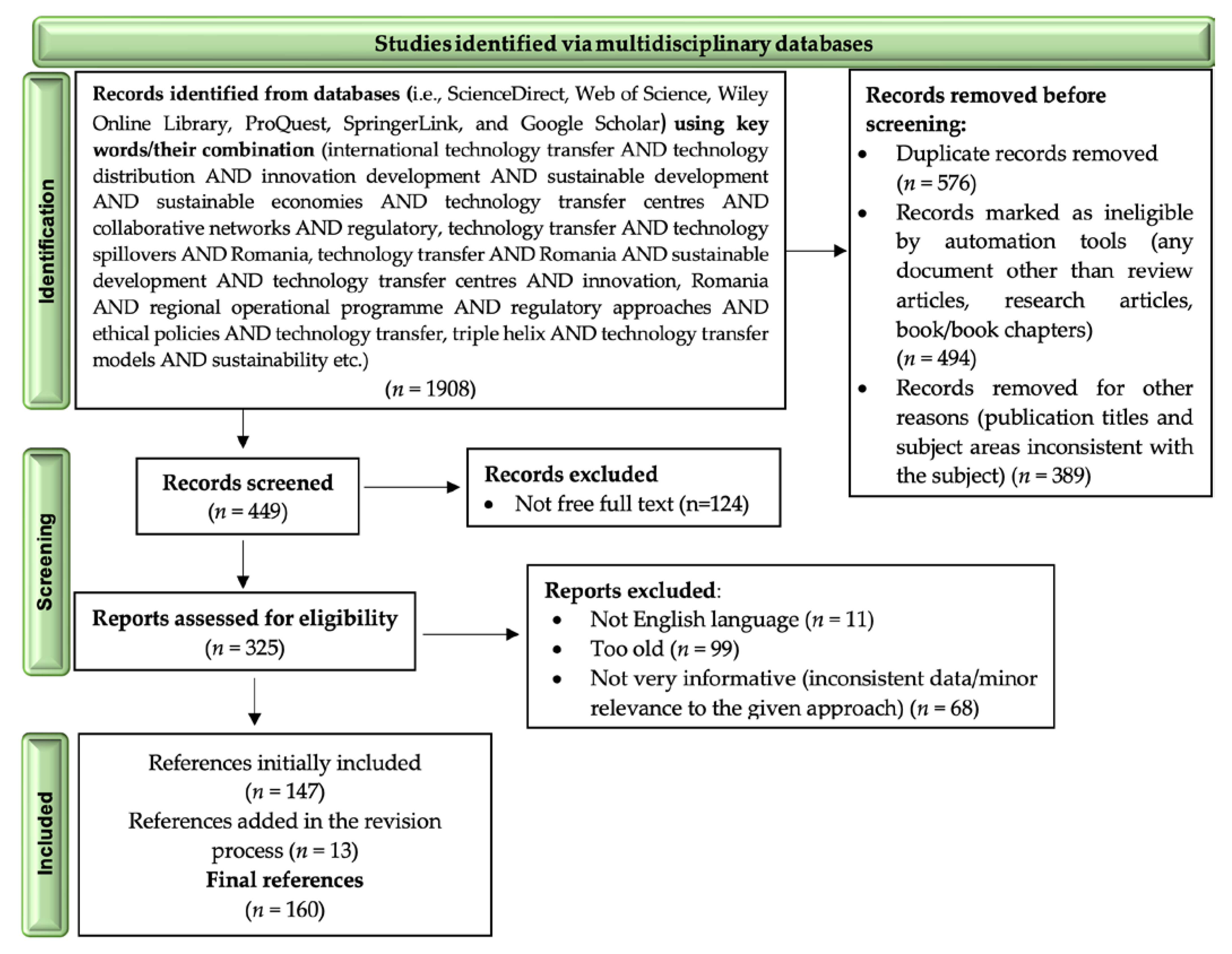
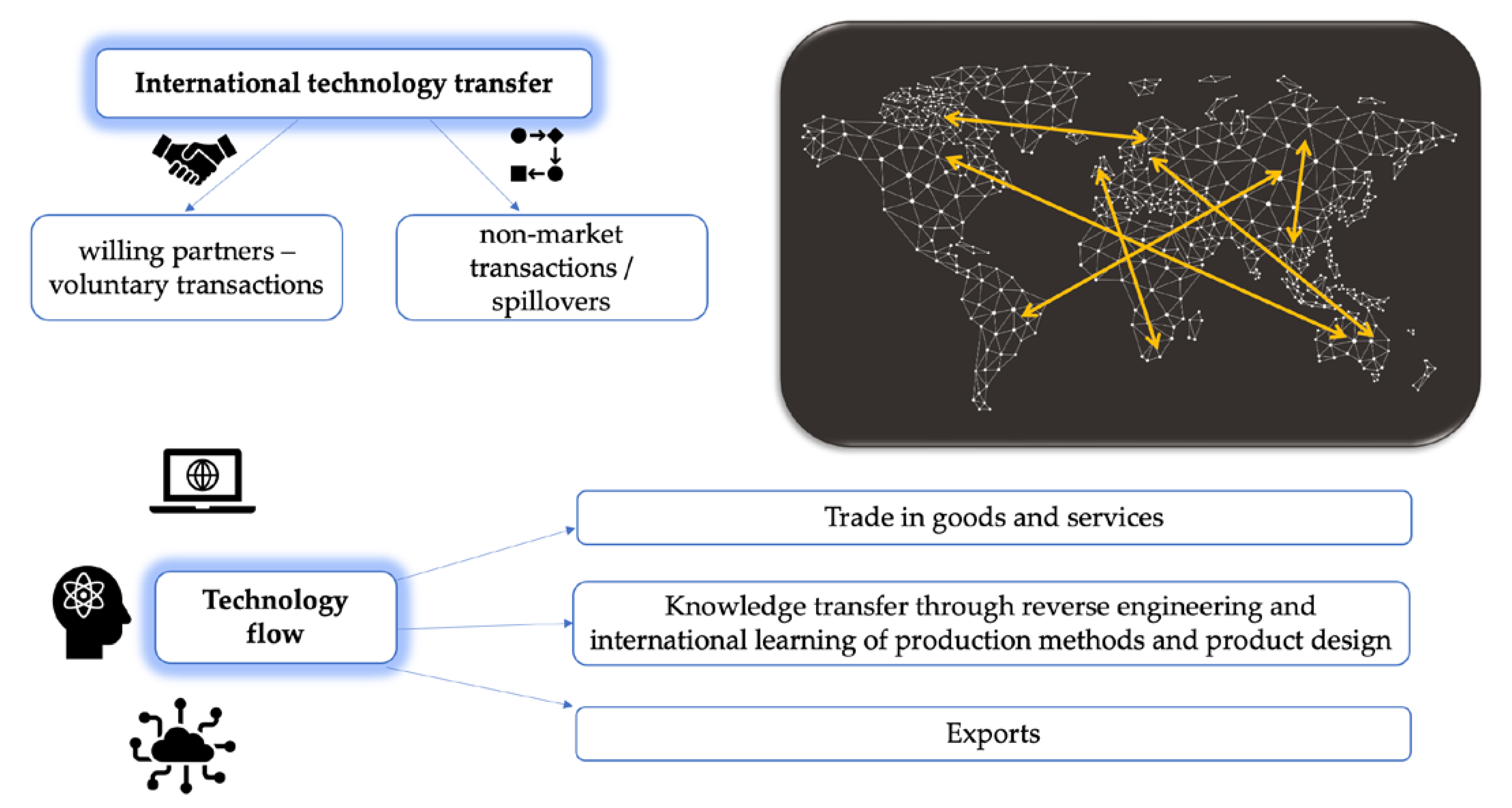
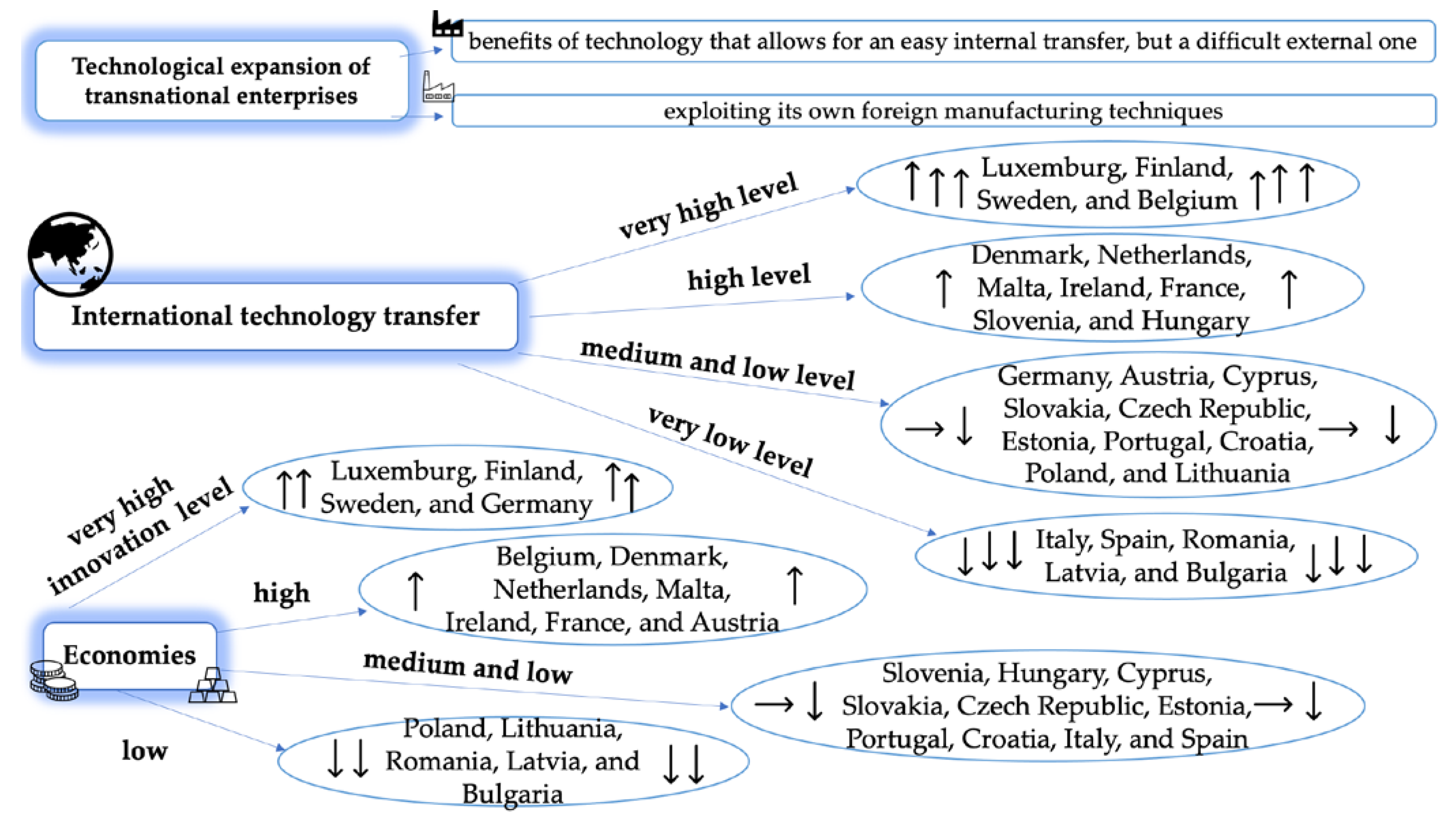


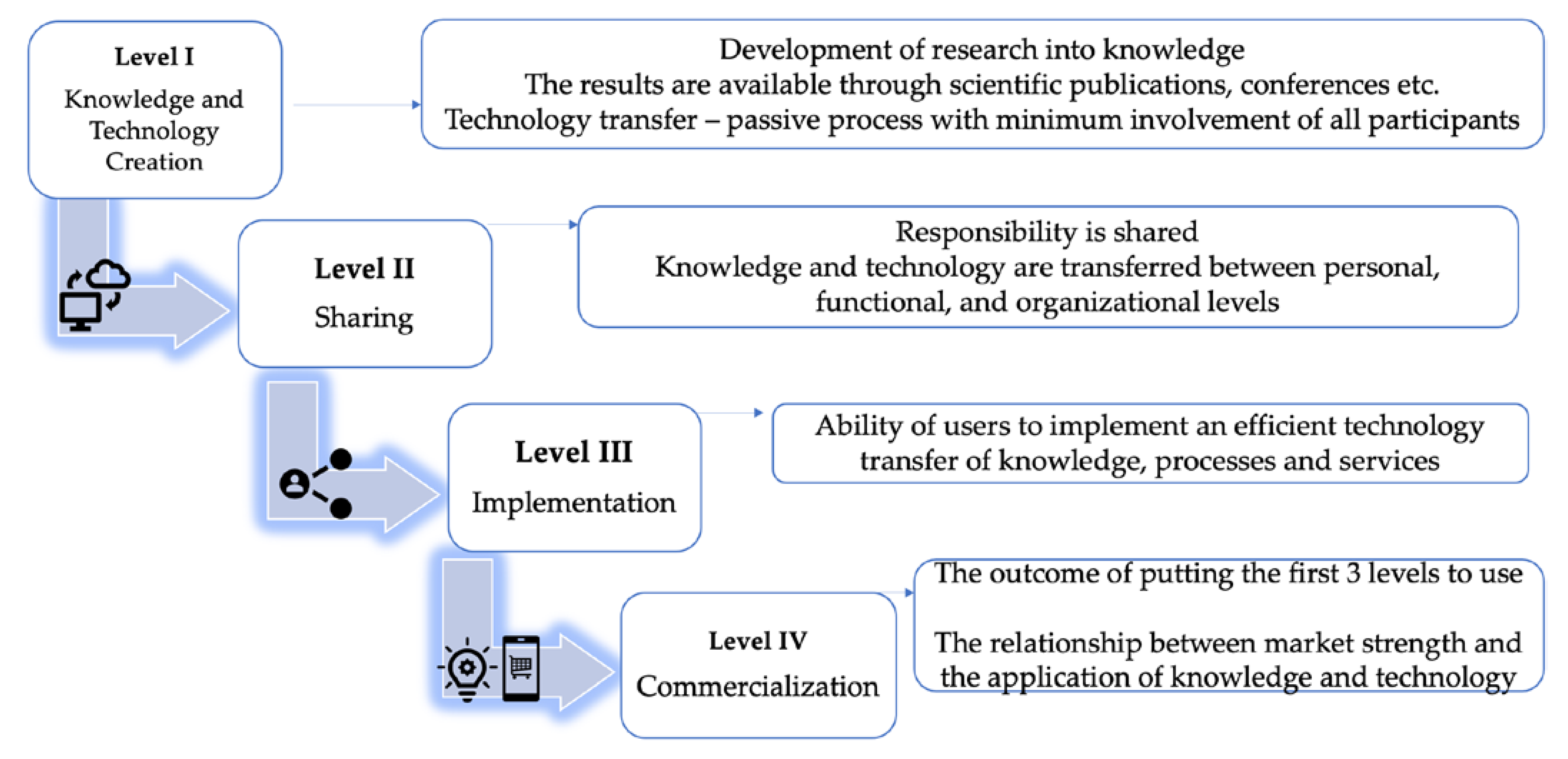
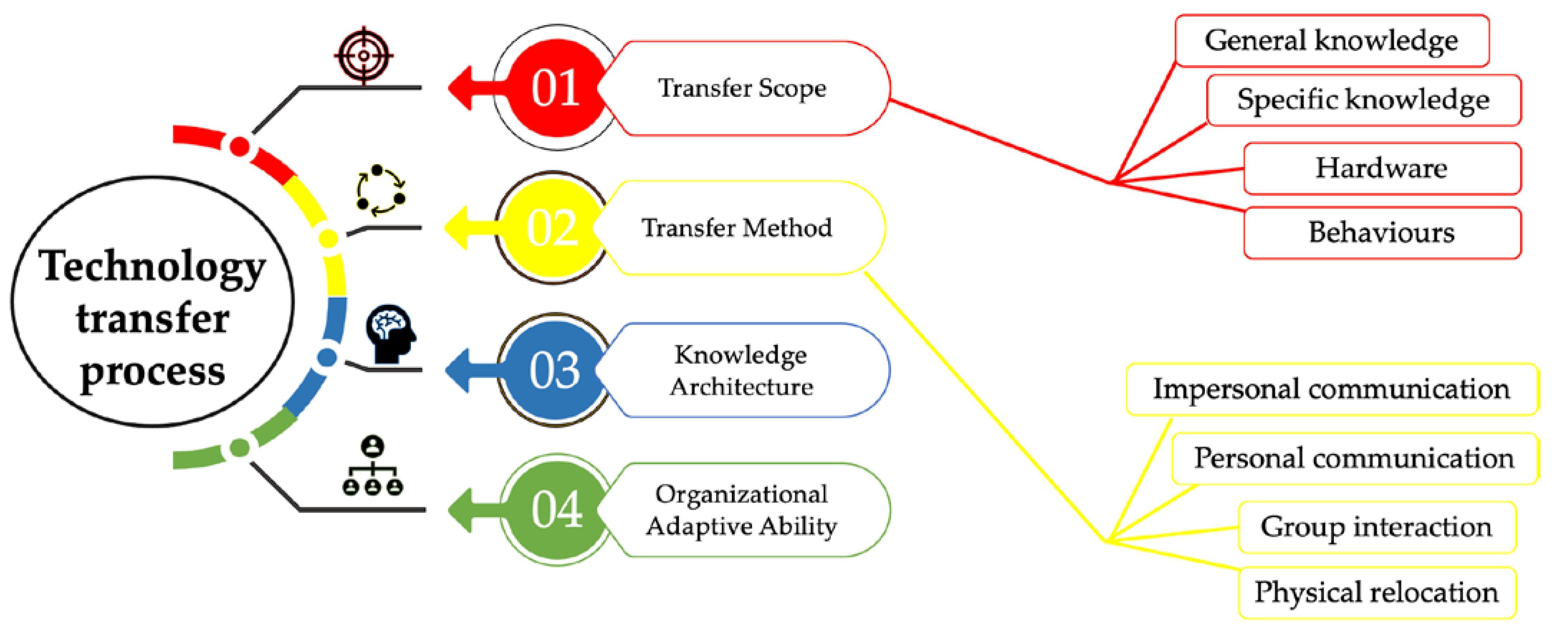
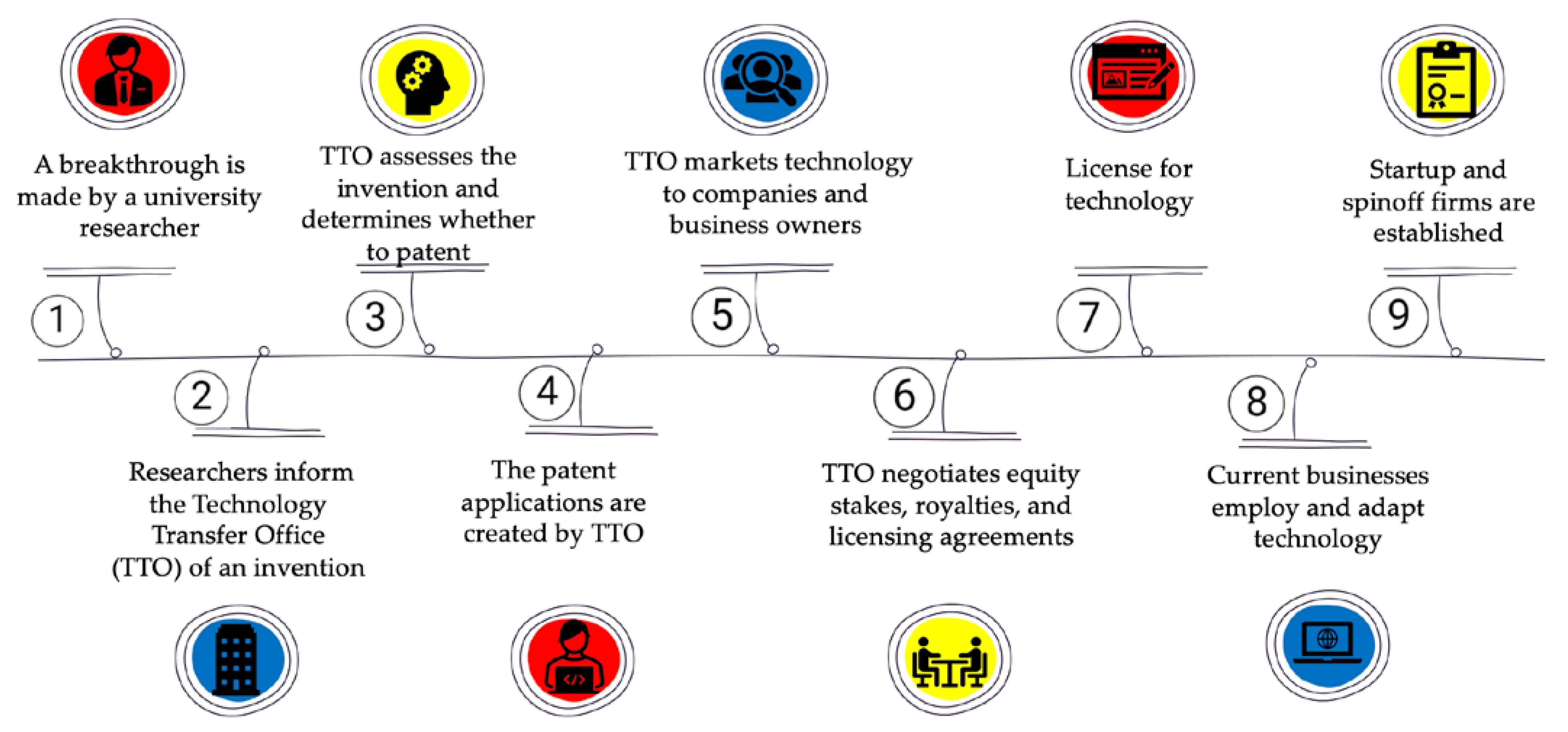
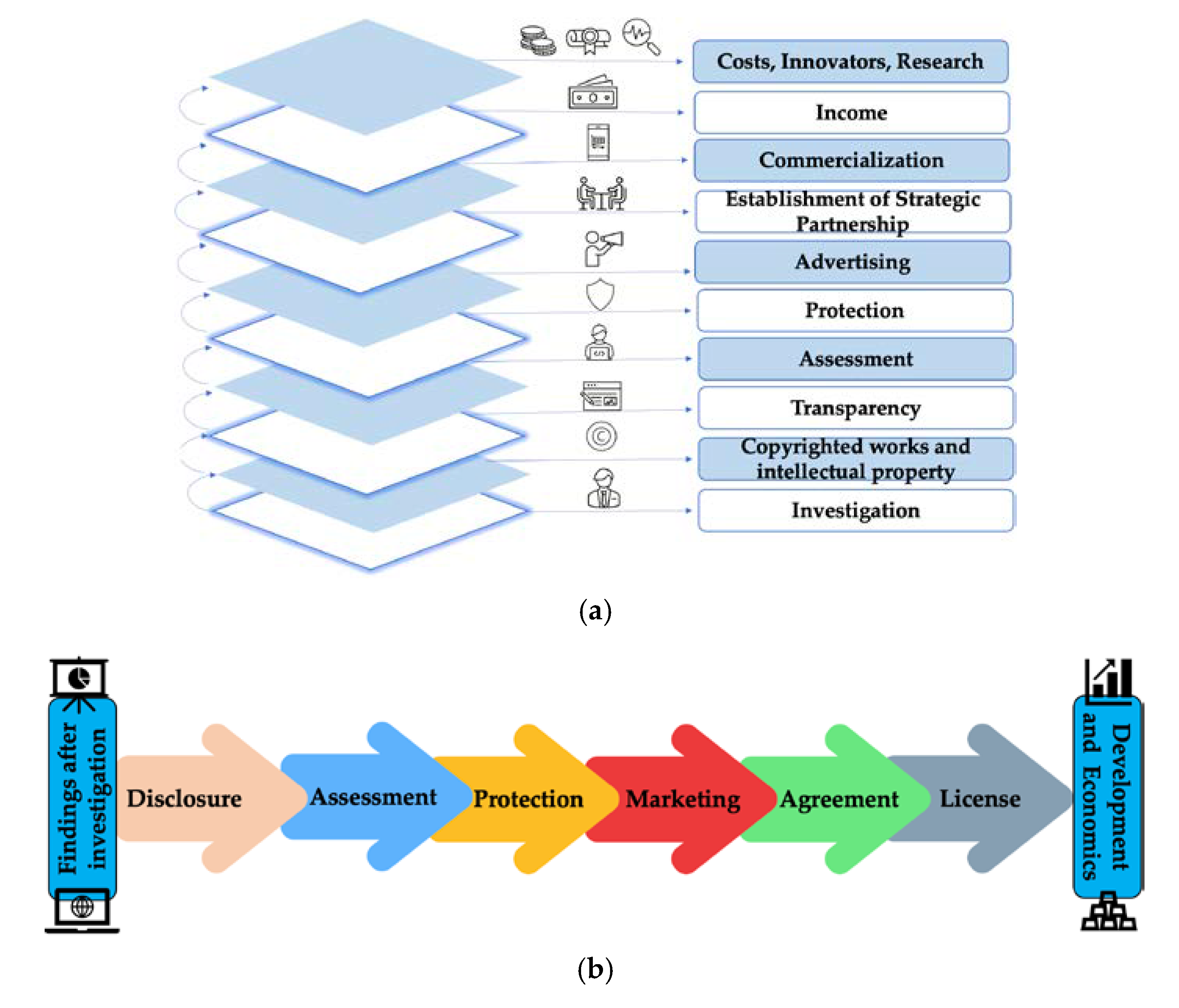



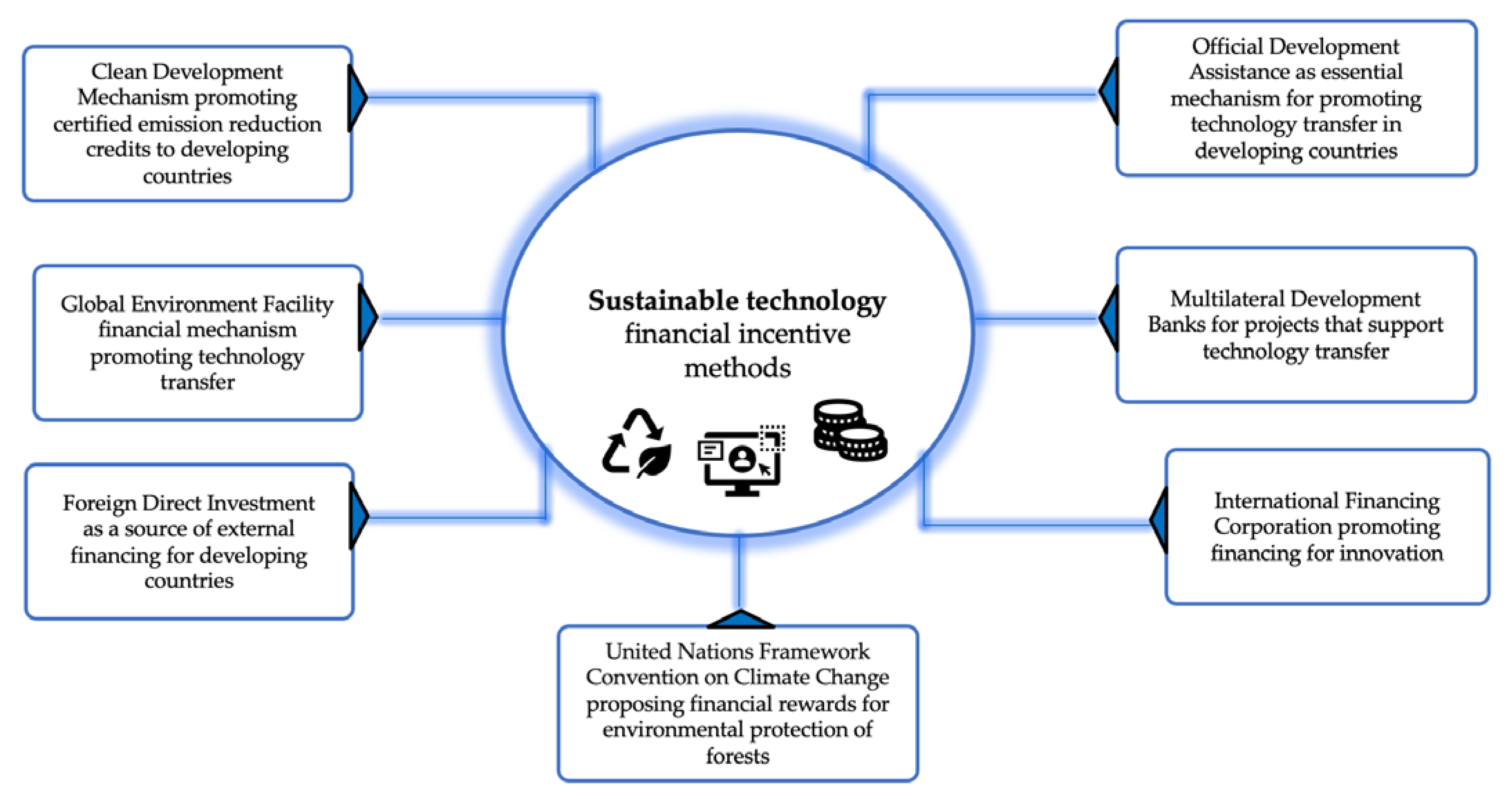
| Range | Model’s Key Factors | Ref. |
|---|---|---|
| General model of technology transfer, practical case | This model considers the transmission of information, and the promotion of a product is the key to its delivery. | [91] |
| Between areas of a company, conceptual model | It is based on the diffusion process. The model is valid within the same institution, between its agents, and summarizes positive/negative factors that affect the TT process. | [92] |
| University-industry, practical case | The model provides the specific approaches that are used considering the particular characteristics of the agents, describing the role of any new actor that can facilitate the “translation” of the language used between the transmitter/sender and the receiver. | [93] |
| University-industry, conceptual model | The model describes the approach of the system based on the triple helix, the main actors being the university (technology creator), the TTO (intermediary agent) that supports the TT process and the industry (technology receiver). | [94] |
| University-industry, practical case | This model is built based on a given case and details the 7 steps that must be considered in carrying out TT. | [95] |
| Between international industries, quantitative | The model states that TT is conditioned by the socio-political framework, also describing the role and relevance of the learning process based on previous experiences, in order to optimize the next TT processes. | [96] |
| University-company, practical case | This model details 3 levels offered by university research, namely: that of technology, of science, and of use, the TT being realized at any of the levels. | [97] |
| Between areas of a company, conceptual model | This is a model based on another one presented in the literature [92], being completed with the “big environment”, showing that the legislative framework influences TT. | [98] |
| General model of TT, conceptual model | As an essential factor, this model considers the effectiveness criteria for the TT process. The importance of the public is added to the update of the 2015 model, as a determining factor in obtaining the success of a TT. | [99] |
| University/industry, conceptual model | This model states that besides the formal TT, there is an informal TT as well, and considers that a university also has the mission of powering the industry to generate innovation. | [100] |
Publisher’s Note: MDPI stays neutral with regard to jurisdictional claims in published maps and institutional affiliations. |
© 2022 by the authors. Licensee MDPI, Basel, Switzerland. This article is an open access article distributed under the terms and conditions of the Creative Commons Attribution (CC BY) license (https://creativecommons.org/licenses/by/4.0/).
Share and Cite
Craiut, L.; Bungau, C.; Bungau, T.; Grava, C.; Otrisal, P.; Radu, A.-F. Technology Transfer, Sustainability, and Development, Worldwide and in Romania. Sustainability 2022, 14, 15728. https://doi.org/10.3390/su142315728
Craiut L, Bungau C, Bungau T, Grava C, Otrisal P, Radu A-F. Technology Transfer, Sustainability, and Development, Worldwide and in Romania. Sustainability. 2022; 14(23):15728. https://doi.org/10.3390/su142315728
Chicago/Turabian StyleCraiut, Lisa, Constantin Bungau, Tudor Bungau, Cristian Grava, Pavel Otrisal, and Andrei-Flavius Radu. 2022. "Technology Transfer, Sustainability, and Development, Worldwide and in Romania" Sustainability 14, no. 23: 15728. https://doi.org/10.3390/su142315728
APA StyleCraiut, L., Bungau, C., Bungau, T., Grava, C., Otrisal, P., & Radu, A.-F. (2022). Technology Transfer, Sustainability, and Development, Worldwide and in Romania. Sustainability, 14(23), 15728. https://doi.org/10.3390/su142315728











